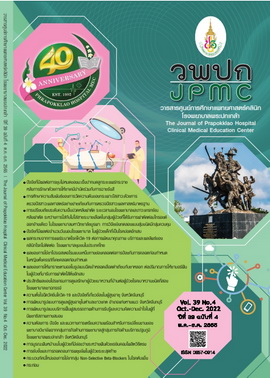Effects of Vaginal Progesterone on The Prevention of Preterm Delivery in Pregnant Women with Prior Spontaneous Preterm Birth
Main Article Content
Abstract
BACKGROUND: The preterm birth rate in Thailand continues to rise. Moreover, perinatal morbidity and mortality are causing significant budget losses for treatment. Rayong Province had a preterm birth rate as high as 11% from 2017 to 2018, and progesterone was often used to prevent preterm birth.
OBJECTIVES: To study the rate of preterm birth after vaginal progesterone use among singleton pregnancies with prior spontaneous preterm birth.
METHODS: A retrospective cohort study was conducted with historical control from the medical records of 82 singleton pregnancies in women who had a history of preterm birth and used vaginal progesterone at Rayong Hospital from 2019 to 2021.
RESULTS: The preterm birth rate was 20.7% in pregnant women with previous preterm birth who used vaginal progesterone. Comparison of current gestational age and previous preterm gestational age showed the mean gestational age was 37.3±1.7 weeks and 32.1±3.2 weeks, respectively. The current gestational age was significantly higher than previous preterm gestational age by about 5.20 weeks of mean gestational age (95%CI:4.47,5.92) (p<0.001) and when clarified by previous preterm gestational age to intervals of less than 28 weeks, 28-32 weeks, and greater than 32 weeks. The study found that the current gestational age was significantly higher than the previous preterm gestational age (p<0.001) in all intervals.
CONCLUSION: The use of vaginal progesterone in a pregnancy with previous preterm delivery can reduce the preterm birth rate by 79.3% as well as increase the current gestational age.
Thaiclinicaltrials.org number, TCTR20220527007
Article Details

This work is licensed under a Creative Commons Attribution-NonCommercial-NoDerivatives 4.0 International License.
References
Cunningham FG, Leveno KJ, Bloom SL, Spong CY, Dashe JS, Hoffman BL, et al. Williams Obstetrics. 24th ed. New York: McGeaw Hill; 2013.
Iams JD, Goldenberg RL, Mercer BM, Moawad A, Thom E, Meis PJ, et al. The preterm prediction study: recurrence risk of spontaneous preterm birth. National institute of child health and human development maternal-fetal medicine units network. Am J Obstet Gynecol1998 ;178:1035-40.
Spong CY. Prediction and prevention of recurrent spontaneous preterm birth. Obstet Gynecol 2007;110 (2 Pt 1):405-15.
Meis PJ, Klebanoff M, Thom E, Dombrowski MP, Sibai B, Moawad AH, et al. Prevention of recurrent preterm delivery by 17 alpha-hydroxyprogesterone caproate. N Engl J Med 2003; 348:2379-85.
Fernandez-Macias R, Martinez-Portilla RJ, Cerrillos L, Figueras F, Palacio M. A systematic review and meta-analysis of randomized controlled trials comparing 17-alpha-hydroxyprogesterone caproate versus placebo for the prevention of recurrent preterm birth. Int J Gynaecol Obstet 2019;147:156-64.
Society for Maternal-Fetal Medicine (SMFM) Publications Committee. The choice of progestogen for the prevention of preterm birth in women with singleton pregnancy and prior preterm birth. Am J Obstet Gynecol [Internet]. 2017[ cited 2022 Jan 15];216(3):B11-3. Available from: https://www.ajog.org/action/showPdf?pii=S0002-9378%2817%2930129-1
Ashoush S, El-Kady O, Al-Hawwary G, Othman A. The value of oral micronized progesterone in the prevention of recurrent spontaneous preterm birth: a randomized controlled trial. Acta Obstet Gynecol Scand 2017;96:1460-6.
Abdou AM. Role of vaginal progesterone in prevention of preterm labor in women with previous history of one or more previous preterm births. Open J Obstet Gynecol 2018;8:329-37.
Care A, Nevitt SJ, Medley N, Donegan S, Good L, Hampson L, et al. Interventions to prevent spontaneous preterm birth in women with singleton pregnancy who are at high risk: systematic review and network meta-analysis. BMJ [Internet]. 2021[cited 2022 Jan 15];376: e064547. Available from: https://doi.org/10.1136/bmj-2021-064547
Brown R, Gagnon R, Delisle MF. Cervical insufficiency and cervical cerclage. J Obstet Gynaecol Can 2013;35:1115-27.
Daniel WW. Biostatistics: a foundation for analysis in the health sciences. 6th ed. New York: Wiley & Sons; 1995.

